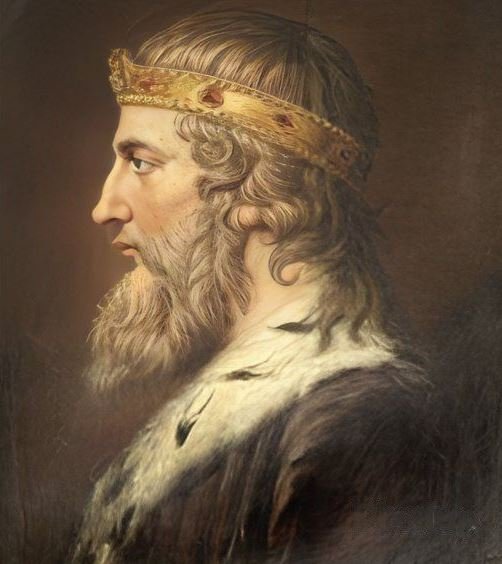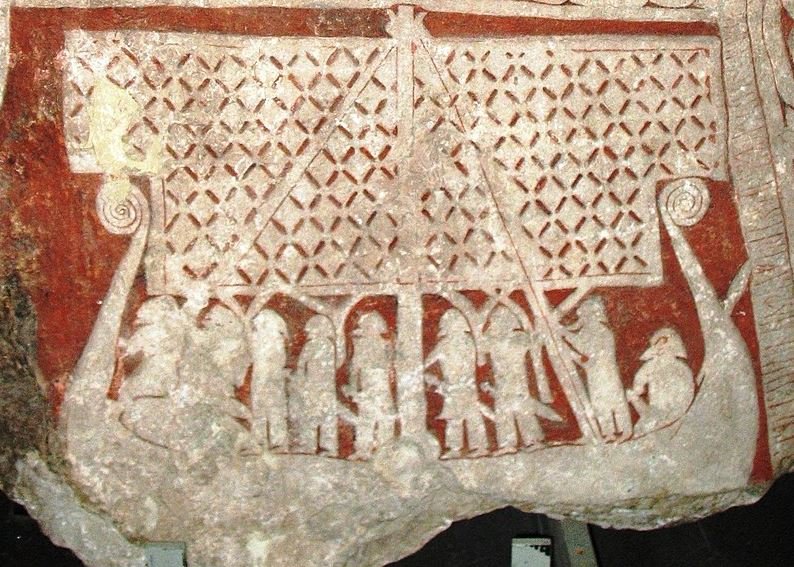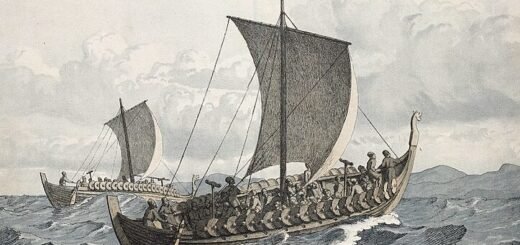What was the Great Heathen Army?
The Great Heathen Army, a formidable force in the annals of British history, marked a turning point in the Viking Age and the history of England. This army was not merely a band of raiders but a sophisticated coalition of Norse warriors, primarily from Denmark but also including warriors from Norway and Sweden.
Unbeknownst to many, the Great Heathen Army sought conquest and settlement rather than mere plunder. Their arrival on the shores of the British Isles in 865 AD heralded a period of intense and transformative conflict that would ultimately shape the political and cultural landscape of England.
Origins and Context
The Viking Age, which spanned from the late 8th to the late 11th century, was characterized by the Norse peoples’ expansion through raiding, trading, and settling across Europe and into the North Atlantic.
The reasons behind the Viking expeditions are multifaceted, including overpopulation at home, political strife, the lure of wealth in the rich monasteries and settlements of the British Isles, and advancements in shipbuilding that facilitated long-distance travel.
The Great Heathen Army’s formation was a significant escalation in Viking activity in England. Previously, Viking raids were smaller, hit-and-run affairs conducted by independent bands. The assembly of such a large force suggested a well-organized, concerted effort to seize land and establish Norse control over territories in England.

The Invasion Begins
In 865 AD, the Great Heathen Army landed in East Anglia. The choice of landing site was strategic; East Anglia offered easy access to the rich lands of Northumbria, Mercia, and Wessex.
Initially, the East Anglians attempted to buy peace by supplying the Vikings with horses, which only enabled the invaders to strike deeper into England.

The Great Heathen Army, a vast Scandinavian coalition, invaded England in AD 865, escalating from prior Viking raids to aim at conquering East Anglia, Northumbria, Mercia, and Wessex, signifying a shift from plunder to occupation. Image: A map showing Great Heathen Army’s route between 865 and 878.
Campaigns and Conquests
The army quickly moved north, capturing York (Jorvik) in 866 AD. This proved to be a significant victory as it provided them with a strong operational base in Northumbria.
The following years saw a series of brutal campaigns against the other major Anglo-Saxon kingdoms. In 867 AD, Northumbria fell to the Vikings, followed by Mercia in 874 AD. Wessex managed to resist under the leadership of King Alfred the Great, marking the beginning of a protracted struggle that would culminate in Alfred securing a peace agreement with the Vikings. This peace treaty ultimately led to the establishment of Danelaw – a term referring to the swathes of England under Norse law.
The Army’s Composition and Tactics
The Great Heathen Army’s exact size is unknown, but historical and archaeological evidence suggests it was a large and well-organized force, possibly numbering in the thousands. This army was composed of veteran warriors who had honed their skills in numerous raids and battles across Europe. They employed a combination of shock tactics, mobility, and psychological warfare that overwhelmed the often fragmented and unprepared Anglo-Saxon kingdoms.
Their military success was also due in part to their superior mobility, facilitated by their longships, and their ability to strike quickly and unexpectedly along the coasts and rivers.
Also, the Vikings’ use of fortified encampments, known as longphorts, allowed them to secure territories and defend against counterattacks effectively.
Cultural Impact and Legacy
The Great Heathen Army’s invasion had a profound impact on the cultural and political landscape of England.
The Norse settlers introduced their language, customs, and laws into the regions they controlled, leaving a lasting legacy in place names, language, and legal practices in parts of England.
The Danelaw, the region of England under Norse control, maintained distinct cultural and legal practices for centuries.
The conflict and eventual settlements also led to the assimilation of Norse settlers into Anglo-Saxon society, contributing to the rich cultural tapestry of England. The fusion of Norse and Anglo-Saxon cultures is evident in various aspects of English society, from language and law to place names and folklore.
The Path to a Unified England
The struggle against the Great Heathen Army and subsequent Norse settlers played a crucial role in the unification of England. Faced with a common enemy, the Anglo-Saxon kingdoms were eventually compelled to cooperate, laying the groundwork for a unified English kingdom.
King Alfred the Great’s successful defense of Wessex and his vision for a united England were instrumental in this process. The establishment of fortified towns (burhs) by Alfred and his successors helped to secure the kingdom against further Viking raids and fostered the growth of trade and urbanization.
In the end, this contributed to the consolidation of royal authority and the emergence of a unified English state.

How did the formation of Great Britain and the United Kingdom happen?
FAQs
Where did the name the Great Heathen Army come from?
The origin of the name can be traced to the Anglo-Saxon Chronicle.
The Anglo-Saxon Chronicle, written in Old English, compiles annals detailing Anglo-Saxon history. This crucial historical document spans from the early 5th century to the 12th, offering a comprehensive view of events, culture, and societal shifts, making it an invaluable resource for understanding the early medieval period in what is now England.
Who were the main leaders of the Great Heathen Army?
The Great Heathen Army was commanded by Ragnar Lodbrok’s sons—Halfdan, Ivar the Boneless, and Ubba. This formidable force waged a 14-year campaign against Anglo-Saxon kingdoms. While sources don’t specify its size, it’s noted as one of the era’s largest invading forces, showcasing the significant impact and legacy of these Viking leaders and their quest in medieval England.
Where did the Great Heathen Army first land?
The Great Heathen Army first arrived in East Anglia in 865 and thereafter secured horses from the local king for peace.
What places were the first to suffer from the Great Heathen Army?
After wintering in Thetford, they captured York in November 866, a city with Roman and Anglo-Saxon heritage. In 867, these fierce Scandinavian warriors penetrated Mercia, wintering in Nottingham, and returned to York the following winter. By 869, they had reconquered East Anglia, killed its king, and resettled in Thetford for winter.
How did Alfred the Great handle the threat of the Great Heathen Army?

Alfred the Great, King of Wessex from 871 to 899, faced one of the most formidable challenges to Anglo-Saxon England: the invasion of the Great Heathen Army, a coalition of Norse warriors. Image: A painting of Alfred by British artist Samuel Woodforde.
In 871, Vikings targeted Wessex, where Alfred the Great paid them off. They wintered in London, then moved to York for reinforcements, later campaigning in Mercia. King Burgred fled, replaced by Coelwulf. After wintering at Repton, they split; some settled in Northumbria, others invaded Wessex.
By 878, Wessex stood unconquered. Alfred defeated the Vikings at Battle of Edington in May, leading to a treaty allowing Viking control over much of northern and eastern England.
Alfred the Great’s response to this existential threat was multifaceted, involving military innovation, diplomatic strategy, legal reform, and cultural patronage. His leadership not only repelled the Viking invaders but also laid the foundations for a unified England.
Why exactly did the Great Heathen Army invade England?
The Anglo-Saxon Chronicle omits the invasion’s motive, likely due to the commonality of Viking raids. Contrarily, “The Tale of Ragnar’s Sons” attributes the Great Heathen Army’s invasion to avenge Ragnar Lodbrok’s death by King Ælla of Northumbria, through execution in a snake pit, as per Viking saga.
In reality, the Great Heathen Army’s invasion of England in the mid-9th century is attributed to a combination of factors, including economic, social, political, and environmental reasons.
The Vikings were motivated by wealth, particularly the prospect of plundering the rich monasteries and settlements of England. These raids offered immediate rewards in the form of gold, silver, and other valuables, which were relatively easy to transport back to Scandinavia.
Some scholars suggest that overpopulation in the Viking homelands may have prompted the invasions. The search for new territories to settle and farm could have driven the Vikings to look beyond their native lands, with England offering fertile lands suitable for agriculture.
Furthermore, the period saw the emergence of more centralized political structures in Scandinavia, with powerful leaders seeking to expand their influence and territories. The invasions could have been a way to gain prestige, secure resources, and find new lands for their followers.
Another potent motivation for the Vikings’ invasion of England had to do with trade and economic expansion. The Vikings were not just raiders but also traders and explorers. The invasion could partly have been motivated by the desire to control trade routes and access to markets in the British Isles and beyond.
Also, advances in shipbuilding and navigation allowed the Vikings to travel further and with more considerable force. The longships enabled them to launch surprise attacks on coastal monasteries and towns, making the invasions more feasible and attractive.
There were instances of provocation that could have led to retaliatory attacks. Additionally, the internal divisions and political instability within the Anglo-Saxon kingdoms presented an opportunity that the Vikings exploited, finding it easier to attack and conquer divided territories.
One must also note that the Viking culture valued heroism, adventure, and the accumulation of wealth and status through raiding. Young warriors sought to enhance their reputations and social standing by participating in these raids.
Finally, some research suggests that changing climatic conditions might have made farming in Scandinavia more challenging, pushing communities to seek out new lands and resources.

The Great Heathen Army’s campaign in England was not merely a series of raids but a concerted effort that led to significant Norse settlement and influence in England, shaping the country’s history for centuries to come. Image: A depiction of a Viking battle ship.



























